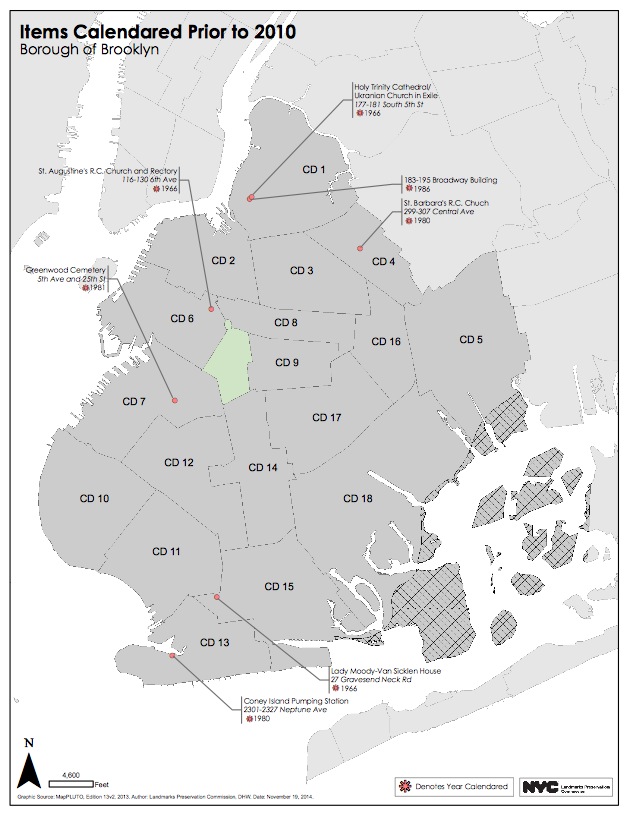Big Surprise: Landmarks Says Yes to Lady Moody House, No to Coney's Pumping Station
In a stunning turnaround and victory for preservationists in Brooklyn, the Landmarks Preservation Commission Tuesday voted to save six of the seven Brooklyn sites on its “backlog” list of 96 sites citywide. Initially, the commission’s new chair, de Blasio appointee Meenakshi Srinivasan, had planned to dump the whole bunch with no public hearings. Many had…

In a stunning turnaround and victory for preservationists in Brooklyn, the Landmarks Preservation Commission Tuesday voted to save six of the seven Brooklyn sites on its “backlog” list of 96 sites citywide. Initially, the commission’s new chair, de Blasio appointee Meenakshi Srinivasan, had planned to dump the whole bunch with no public hearings. Many had been on the commission’s calendar for more than 20 years.
Most notably, one of Brooklyn’s oldest structures, the Lady Moody House at 27 Gravesend Neck Road, got the green light for designation. The privately owned and occupied English farmhouse dates from Gravesend’s earliest days.
It was constructed about 1700 on top of a cellar from an earlier 1600s house. Recently for sale — it was taken off the market just a few days ago — preservationists feared for its future.
None of the sites were actually landmarked Tuesday — that will come later.
All together, 30 of the 96 sites citywide were deemed worthy of landmarking. Five sites were removed from the list “based on their lack of merit,” said the LPC, and 45 sites were issued “no action letters.” (They could be nominated again.)
Surprisingly, Brooklyn’s Coney Island Pumping Station was among the latter. During the hearing, the Art Deco structure received a strong show of support, and it seemed a shoo-in for designation because it is owned by the city.
Read on to find out all the deets on what, where, and why.

Lady Moody-Van Sicklen House
27 Gravesend Neck Road
Calendared: 1966
History: One of the most significant historic structures in Brooklyn, according to City Councilman Mark Treyger, the Lady Moody-Van Sicklen House was built sometime between 1659 and 1700 by English Anabaptists. It contains much original material, including 15th-century cellar walls, heavy oak beams, two fireplaces, narrow stairs, floors, and the initials of Thomas Hicks carved into an original beam in the living room.
Status: Prioritized for designation

Coney Island Pumping Station
2301-2327 Neptune Avenue
Calendared: 1980
History: The Art Deco (specifically Art Moderne) structure was built in 1937 to provide water to fight fires on Coney Island. The only municipal building designed by well-known architect Irwin Chanin, it is owned by the city. Numerous supporters argued it should become a community arts and environmental center.
Status: Letter of no action

Green-Wood Cemetery
5th Avenue and 25th Street
Calendared: 1981
History: The Père Lachaise of New York City, the extremely significant Green-Wood Cemetery was New York’s most popular tourist attraction in the 19th century. Its owners and many supporters, including noted preservationist Otis Pearsall, argued the working cemetery is impractical to designate as a whole. The LPC instead voted to save three structures within the grounds: The Caretaker’s Residence and Visitor’s Cottage, built circa 1876, and designed by famed architect Richard Upjohn; the 1911 chapel by Warren and Whetmore, pictured above, and Upjohn’s main entry gates.
Status: Three structures prioritized for designation

St. Augustine’s R.C. Church and Rectory
116-130 6th Avenue
Calendared: 1966
History: Designed in 1888 by notable Brooklyn architecture firm Parfitt Brothers, the Gothic Revival structure features a rocky surface, corner towers, double apse, and a trumpeting angel.
Status: Prioritized for designation

Holy Trinity Cathedral/Ukranian Church in Exile
177-181 South 5th Street
Calendared: 1966
History: Designed by Helme-Huberty & Hudswell and built in 1905 for the Williamsburg Trust Company, this Beaux-Arts building was originally a bank. It became a court in 1915 and a Ukranian church in 1961.
Status: Prioritized for designation

St. Barbara’s Roman Catholic Church
299-307 Central Avenue
Calendared: 1980
History: This Spanish Baroque-style church was designed by Helmle & Huberty and built in 1910. Features include a dome, spires and stained glass windows. The American Institute of Architects guide to New York called it “edible,” on account of its elaborate “wedding-cake icing” decoration.
Status: Prioritized for designation

Forman Building
183-195 Broadway
Calendared: 1986
History: This 1882 cast-iron building in south Williamsburg was a shoe factory and warehouse. It is notable for its unusual Neo-Grec cast-iron ornament showing calla lilies rising from shell-like leaves.
Status: Prioritized for designation

Related Stories
Brooklyn Sites the LPC Has Targeted to Dump
For Less Than $1 Million, You Can Own a Famous 18th-Century Brooklyn Farmhouse
Breaking: Landmarks to “Decalendar” Hundreds of Proposed Historic Sites?
Email tips@brownstoner.com with further comments, questions or tips. Follow Brownstoner on Twitter and Instagram, and like us on Facebook.
[sc:daily-email-signup ]








I am SO glad that St. Barbara’s made the list. When it was calendared in 1980, this wonderful gem was almost completely surrounded by vacant lots and abandoned buildings. Attendance was dwindling and there were rumors that the diocese would shut the building – the same fate that was imposed upon nearby St. Leonard’s. But the parish held out and, with the major development of housing that subsequently occurred in Bushwick’s central core, the community came back to life and the parish is now thriving. The exterior and interior renovations that have also occurred here have greatly enhanced the beauty of this glorious church.
Although, with or without landmarks designation, St. Barbara’s preservation seems pretty secure, at least for the foreseeable future, designation is still welcome both as an added insurance policy and, more importantly, a symbol of the Bushwick community’s survival from a truly dreadful period.